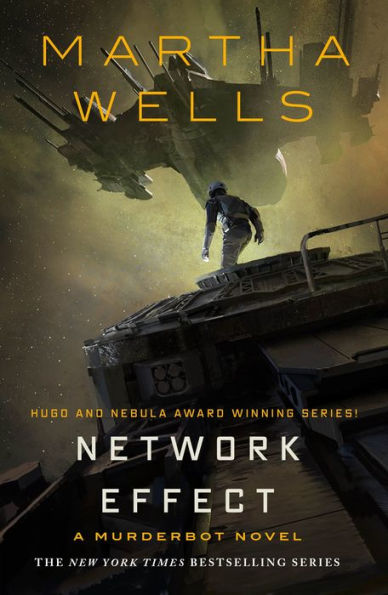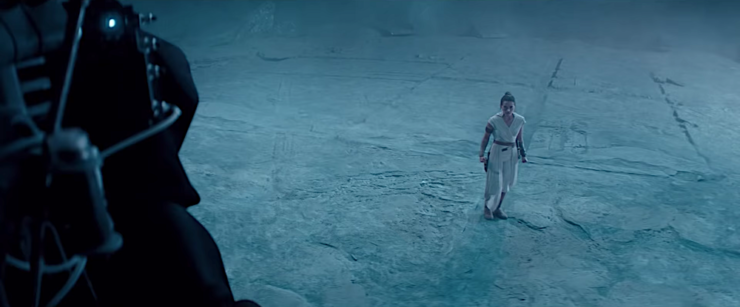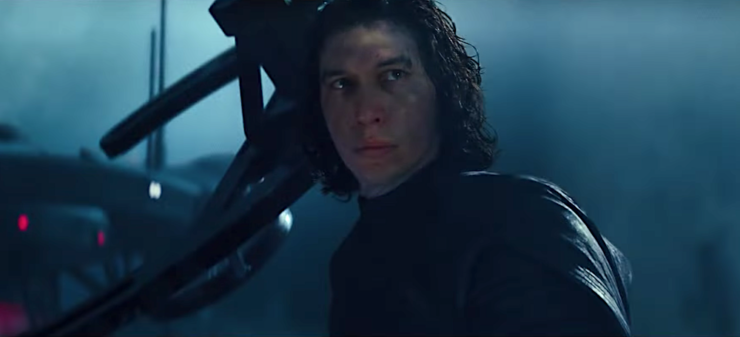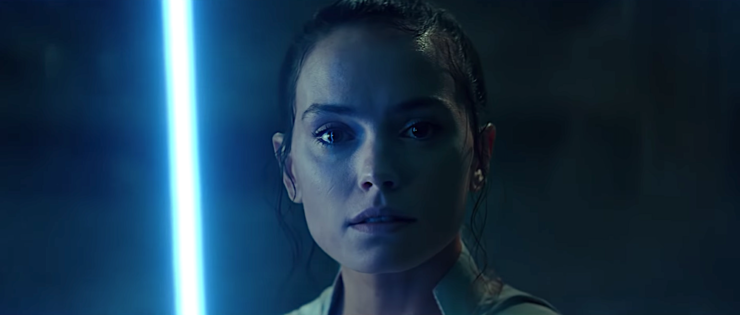It sometimes gets lost in discussion of Star Wars that the Empire and the First Order are, essentially, Space Nazis. Through all three Star Wars trilogies, the villains are members of an authoritarian regime that wants to conquer every world and culture in the galaxy, flatten any kind of rebellion or free thought, and crush individual liberty. Every other fandom argument aside, what the series is about is resistance to oppressive rule, sometimes through fighting and guerilla tactics, sometimes through non-violence.
I’m going to put my cards on the table and tell you I didn’t like The Rise of Skywalker all that much, mostly because I didn’t think it took enough time with that central theme. (Also FinnPoe, but that’s a whole other article.) However, there was one element that the film did quite well, and to talk about it I need to sidetrack us a little bit into Terrence Malick’s A Hidden Life.
Bear with me.
A Hidden Life is a three-hour-long, incredibly moving art film about an Austrian Conscientious Objector who refused to swear allegiance to Hitler during World War II. (Spoiler alert: this does not go well.) Throughout the film, the man has to deal with townspeople, Nazi officials, his defense attorney, and even his mom asking him why he’s doing it. It won’t turn the tide of the war. It won’t save any lives. No one will even know about his sacrifice. And the film makes it clear that every bit of his common sense is agreeing with them, screaming at him to give up and go back to his farm, to preserve his own life, to do what he’s told. It’s clear that every muscle in his body wants to defend himself when the townspeople and prison guards physically attack him. But he doesn’t give up, and he won’t give in to the comfort of violence, because he’s trying to toe a particular moral line. He believes he has free will, which means he has to make a choice about how he uses it—whether anyone knows about the choice or not.
Now, back to Star Wars.
Buy the Book


Network Effect
When we first see Rey in The Rise of Skywalker, it’s not in battle, or as part of the Space Scavenger Hunt, or even using her Jedi powers to woo people to the Resistance’s cause. She’s floating in mid-air, in a mirror of how we last saw Luke on Ahch-to. She’s repeating the words “Be with me” as a mantra. We don’t know who she’s saying it to, or if she’s saying it to the Force itself. Whoever it is, they don’t answer her.
This is a fascinating way to re-introduce us to Rey, because for most of the film series, the spiritual aspect of the Jedi Order was only shown in brief moments before battle, or, slightly, during Luke’s training on Dagobah, where it always seemed more like a gathering of strength than a larger practice. We saw Luke call Leia through the Force, and we saw Vader use it to choke people and move objects with his mind. Obviously the films have used religious imagery, and riffed on real world faiths to build the Jedi Order. There was even enough spiritual imagery in TROS that Vulture’s Abraham Riesman used it as an opportunity to discuss the series’ Jewish imagery with his rabbi. But we haven’t gotten too much on-screen religious training. This changed with Rogue One, where we saw Chirrut Îmwe commune with the Force through a mantra, “I am one with the Force and the Force is with me.” In Chirrut, we have an older man, a Guardian of the Whills but not a trained Jedi, who has spent his life believing in his connection to the Force on pure faith, and creating his own practice to honor that connection.
With Rey we’re seeing a very young person, who’s only been training to be a Jedi for about a year—a brief time with Luke, who resisted teaching her at every turn, and now what appears to be a more regimented training life with Leia, because of course. Rey doesn’t have a tradition yet, not really, but when we see her she’s focusing on meditation. And unlike Luke, who was always so desperate to run off to the action, she seems content to remain passive, communing with the Force in a much more Chirrut-like way.
Still though, even in her passivity, this is more like prayer than passive contemplation. She’s saying “BE with me” not “I AM with the Force”. This is her equivalent of a Disney Princess “I Wish” Song—but she doesn’t get her wish. No Force Ghosts appear, no voices are heard, and she leaves to run through her physical training course.

We don’t return to the idea of Rey’s meditation until the film’s end, but where we stop along the way opens a whole new Jedi path. A few years ago I wrote about passivity in the Star Wars saga, and how most of the most important moments hinged on people risking vulnerability or death rather than fighting—a fascinating choice for an action series that could just rely on laser swordfights to settle every conflict. Rey takes this tradition in an even stronger direction.
When Rey, Finn, Poe, and Threepio drop through the Pasaana sinking fields, they end up face-to-face with a sand serpent. Where Finn and Poe immediately draw their weapons, Rey waves them back. She approaches the creature alone, sees that it’s injured, and uses her hands to heal it. She takes the Jedi ethos to its fullest interpretation. If all life is part of the Force, and the Force is what connects everyone and everything into a vast web of life, then the serpent is as much a part of the Balance as Rey herself. Realizing this, that the Force is behind all of life, she’s able to see solutions that her more rationally-minded friends cannot, just as Chirrut trusted that he could complete his mission on Scaarif, and Luke knew that refusing to fight his father, even against Yoda and Obi-Wan’s direct orders, was the best choice he could make.
But it’s even more than that: choosing to heal the beast rather than fight shows us that Rey is taking a path of compassion as she learns how to be a Jedi. Even her one terrible mistake, when she loses control of her power and destroys a transport, only happens because she was trying to save Chewbacca. Once again we have a hero who uses her powers to protect rather than attack.
Ultimately, Rey’s emphasis on healing becomes the heart of the final part of the Skywalker Saga. After her Force-connection with Kylo Ren, the two face each other in battle, and keep bringing each other to a standstill. Rey finally inflicts what could be a mortal wound on Kylo only because Leia reaches out to her son through their Force connection, reawakening Ben Solo. Rey has no reason to save him. This isn’t Luke redeeming his father, or even the younger, more naive Rey marching into the heart of the First Order to try to redeem Ben Solo and bring him back to Leia. She and Kylo have fought each other and they have fought together. When she pleaded with him to come back, he offered her his hand as co-ruler of the galaxy—and when she refused he responded by attacking Crait and, effectively, killing her master, after already killing the closest thing she had to a father figure. She has no reason to let him live. No reason not to think that killing him will make her life easier, keep her friends safer, and help bring down the First Order. She would be doing the very thing that Yoda and Obi Wan told Luke he needed to do.
And yet.

Instead of leaving him there to die, Rey stops and risks herself again. Even after everything he’s done she heals him, using her own life force just as she did with the sand serpent. And having set the stakes for the last act of the film, it’s Rey’s spiritual practice that defines her as a hero. When Rey faces Palpatine, she, like Luke before her, rejects the path of violence as much as she can. When Palpatine attacks her, she turns to her mantra, retreating into her mind and reciting “Be with me” as Palpatine drains her life. But this time, generations of Jedi hear her and come to her aid, filling her with their strength, and in her last moments giving her the sense of connection she’s always craved. It’s this connection that allows her to turn Palpatine’s Force Lighting back on him. It’s his own violence that finally defeats him.
And, like Luke before her, she dies. But the broken man she healed comes back to help her. Ben Solo, who we’ve only seen as a scared kid or as vicious Kylo Ren, borrows Rey’s technique to give his life force to her, redeeming himself by choosing healing as his last act.
Which is why I found myself thinking really hard about The Rise of Skywalker during that long, beautiful Malick movie I mentioned. Rey isn’t the swashbuckling scavenger-turned-action hero that we might expect. Ben Solo isn’t defined by his physical bravery. In both cases it’s their choice not to fight, to instead heal their enemies, that defines them, and leads to the defeat of Palpatine and the First Order. Choices made quietly, with no expectation of fanfare or success, but simply the belief that opting out of a culture of hatred and violence is the right path to take. These are the choices that will lead to a new, truly free galaxy after generations of war and oppression.
I didn’t like all of the filmmakers’ choices, but I thought it was worth noting that in the midst of an erratic, violent, war-prone world, our biggest sci-fi action franchise regularly reminds us that you don’t always have to be an action hero. Star Wars once again shows us how to fight Nazis: with non-violence, healing, and empathy.
Originally published in January 2020.
Find Leah Schnelbach on Twitter.










